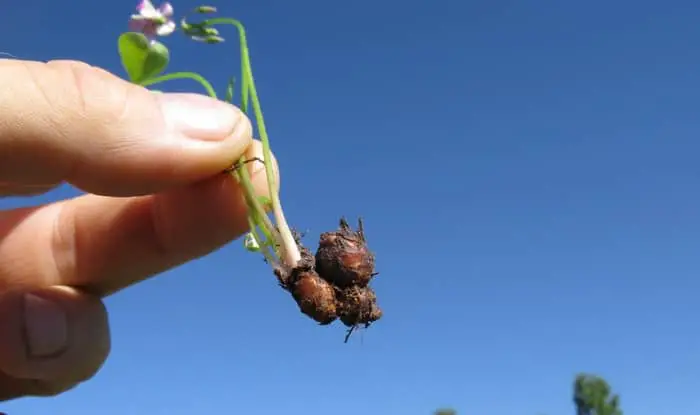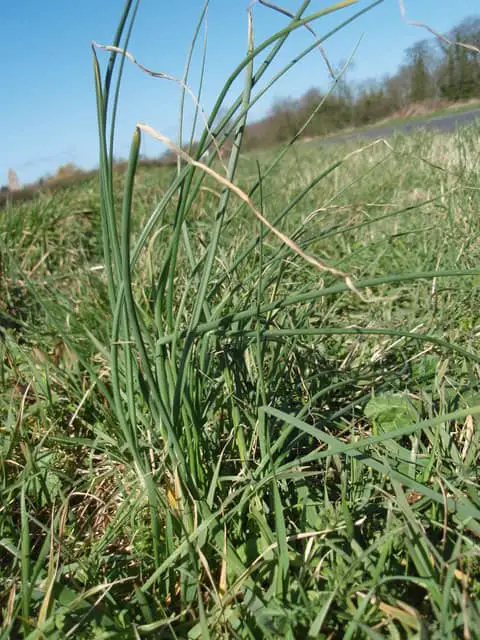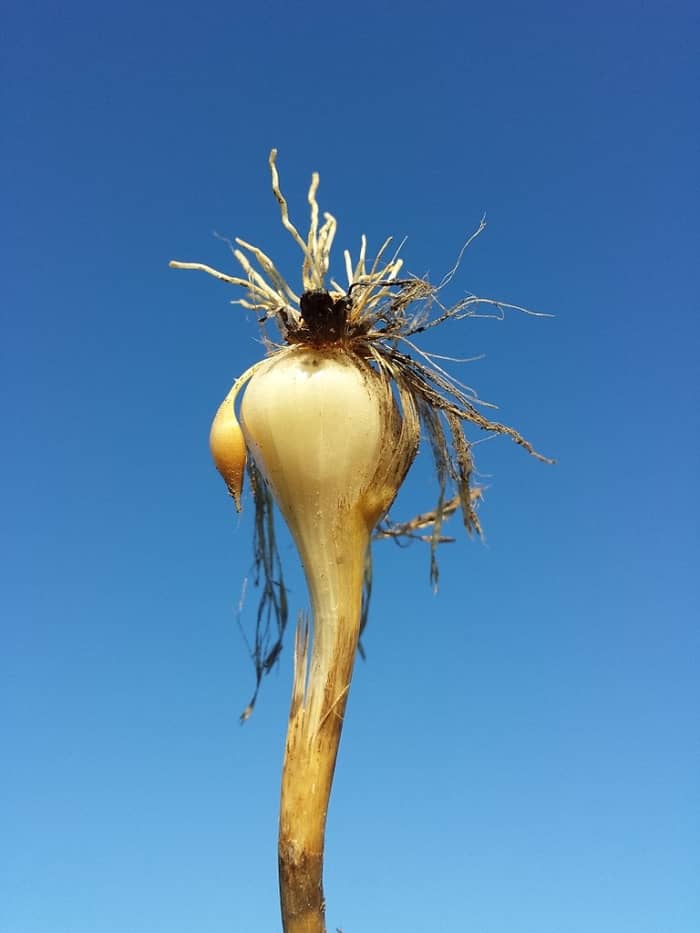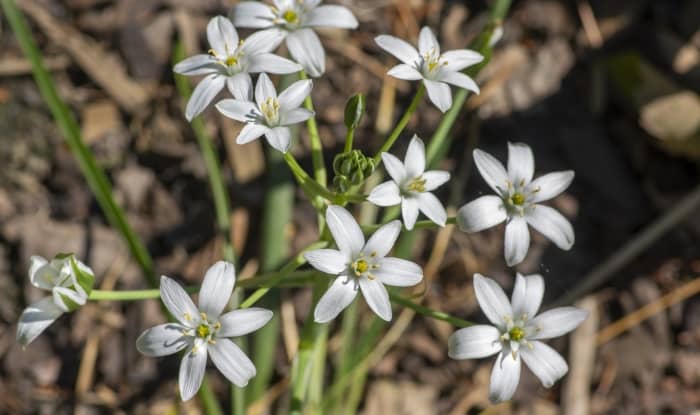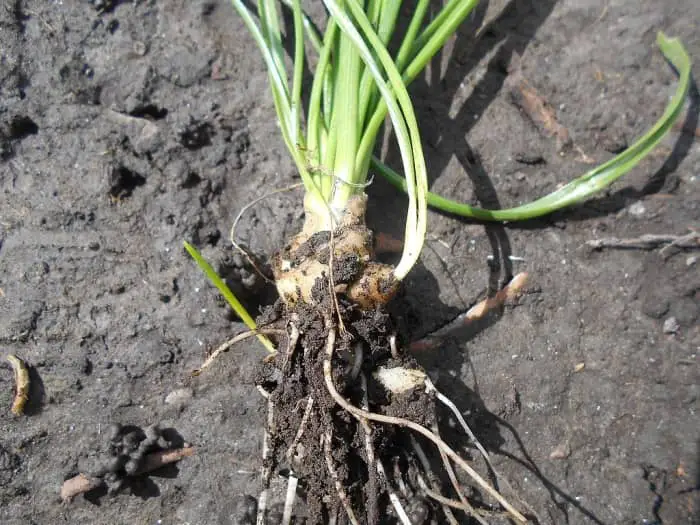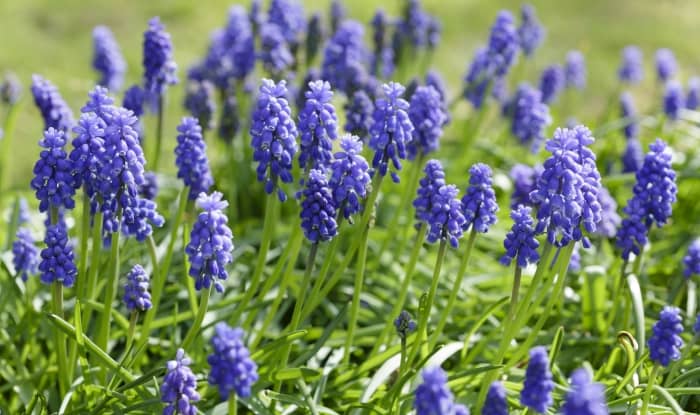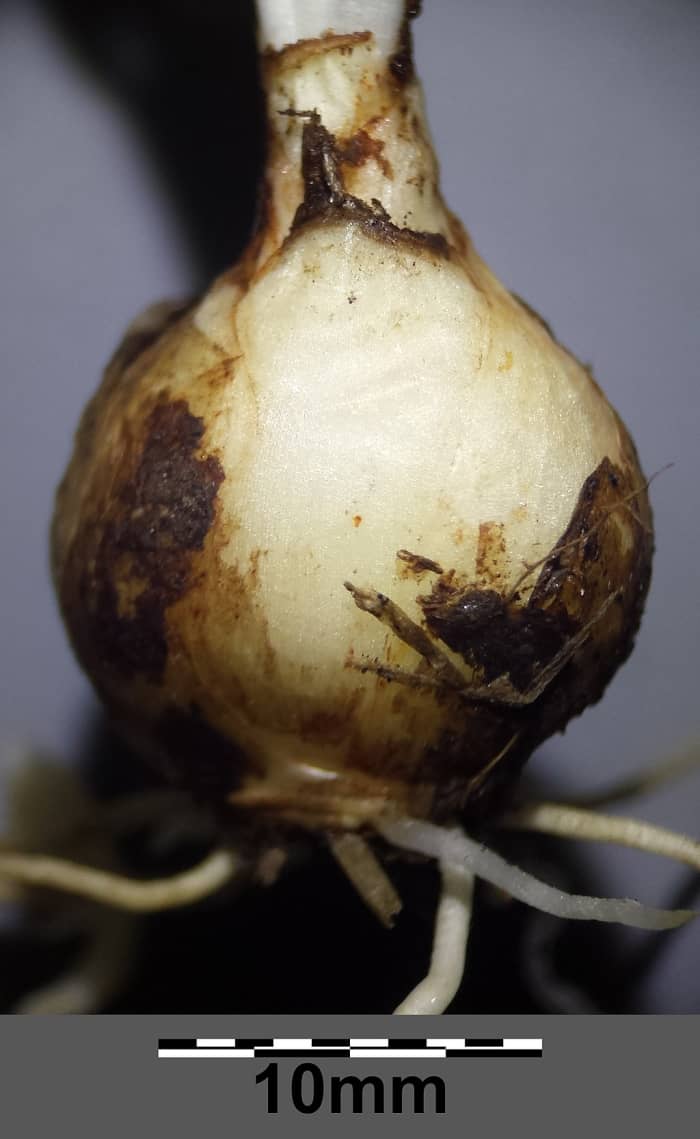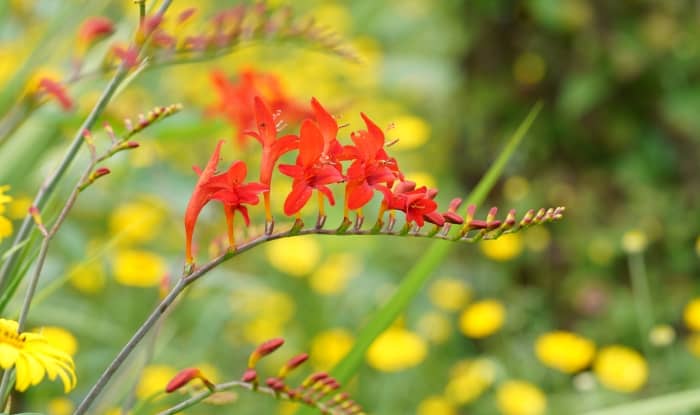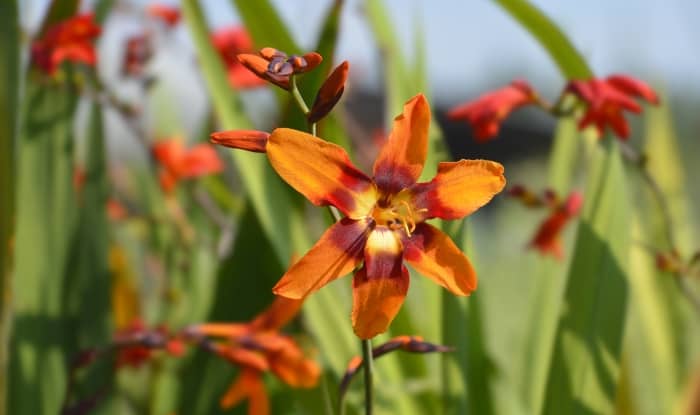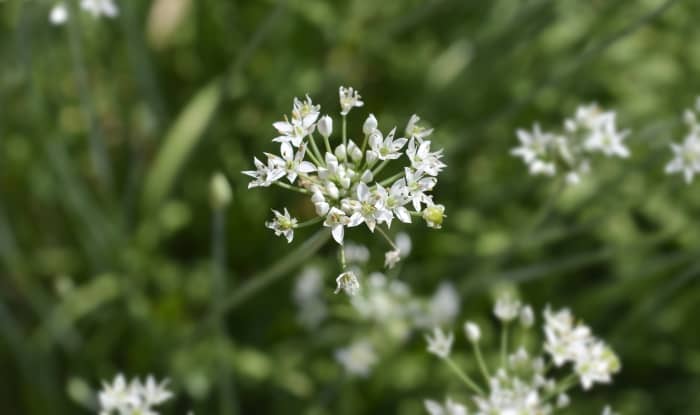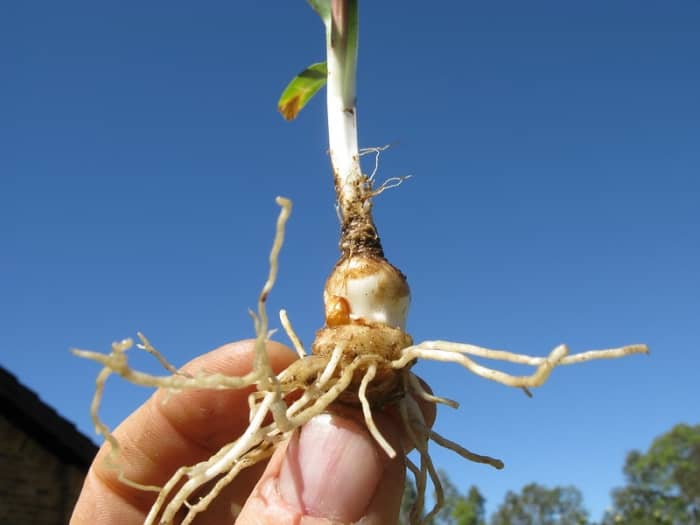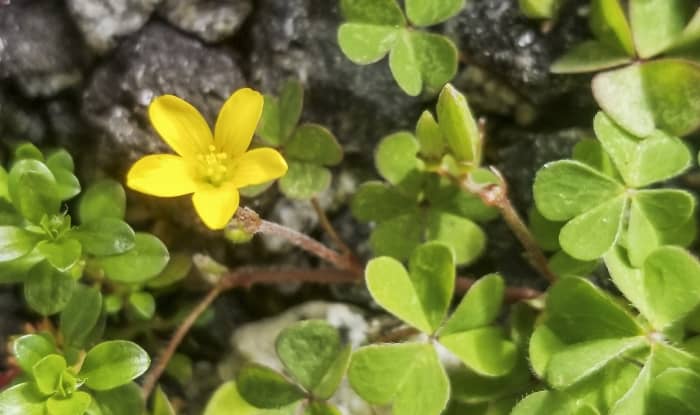Have you discovered some weeds with bulbs in your yard?
I’ll help you identify them using photos and detailed descriptions.
And I’ll tell you the best way to get rid of them.
Let’s dive in.
Common Weeds With Bulbs
Weeds with bulbs have a large underground storage organ that provides a source of nutrients and energy for the growing plant. The bulb consists of a central stem surrounded by layers of fleshy leaves.
Here are some of the most common types of weeds with bulbs you’re likely to come across:
Wild Onion (Allium canadense)
WILD ONION BY MICHAEL TROLOVE, CC BY-SA 2.0
Wild onion grass is a common lawn weed that closely resembles tall grass. But it’s easy to tell the difference when you get close because of the smell.
Wild onion has a strong fragrance that immediately makes them stand out. And this is particularly noticeable after you’ve mowed them.
They’re also very fast-growing. So they quickly rise above the height of the grass on your lawn. And unlike most grasses, they appear in clumps.
Look out for them growing in early spring and late fall. In late spring and summer the weed blooms, with clusters of white or pink flowers appearing at the top of the leaves.
The weed has underground bulbs that persist for several years. And in late spring, the weed also develops aerial bulblets.
WILD ONION FLOWERS BY SAM WILSON
They’re easy to get rid of, you can dig them up with a spade. Make sure you remove the bulb from the ground or they’ll grow back again.
You can also use 3-way broadleaf herbicides that contain 2,4-D, mecoprop, and dicamba. Such as Ortho Weed B Gon for lawns, and Southern Ag lawn weed killer. You will likely need more than one application and it can take multiple seasons to get rid of them.
ALLIUM CANADENSE BY FRANK MAYFIELD
Wild Garlic (Allium vineale)
Also called crow garlic, wild garlic is similar in appearance and growth habits to wild onion. Both weeds are closely related and are part of the lily family.
But while both plants have waxy leaves that are thin and green wild garlic leaves are hollow and round compared to the flat, solid leaves of wild onion (1).
You can also easily tell the difference between the two weeds by the strong garlic odor given off by all parts of Allium vineal.
The underground bulb has a fibrous outer layer, grows 1-2 cm in diameter, and is usually found about 4 inches beneath the soil.
STEFAN LEFNAER, CC BY-SA 4.0, VIA WIKIMEDIA COMMONS
After the weed flowers, it produces aerial bulbils that grow in clusters. The smooth and shiny bulbils initially appear red or brownish and help the plant to reproduce vegetatively.
VICTOR M. VICENTE SELVAS, CC BY-SA 3.0, VIA WIKIMEDIA COMMONS
Lesser Celandine (Ficaria verna)
Also called fig buttercup, lesser celandine is a perennial weed originally introduced to the United States from Europe as an ornamental plant.
The weed grows in dense mats, outcompeting turfgrass growing in shady locations and displacing spring ephemerals from woodland areas as it spreads. Many US states now list lesser celandine as an invasive and noxious weed species.
The weed has a rosette of small kidney or heart-shaped leaves and blooms during March and April, with bright yellow flowers.
STEFAN LEFNAER, CC BY-SA 4.0, VIA WIKIMEDIA COMMONS
Lesser celandine grows from fleshy tubers and bulblets in the soil and can regrow from any pieces left behind, making it difficult to pull by hand. Often, the best way to control the weed’s spread is by using a post-emergent herbicide.
The weed likes moist conditions and it’s commonly found near water sources such as ponds, streams, and marshes.
Star Of Bethlehem (Ornithogalum umbellatum)
Star of Bethlehem is a perennial weed that grows from a bulb and is often mistaken for wild onion, wild garlic, or a grass.
Originally sold as an ornamental, star of Bethlehem has escaped and become a weed of lawns, landscapes, pastures, and hayfields. Star of Bethlehem is mostly found in the northern United States.
You can identify the weed by its dark green and shiny leaves with a white mid-rib. The leaves grow up to 12 inches long and have a hollow cross-section.
When in bloom, the weed has white flowers with six petals that grow at the end of leafless stems. 3-lobed capsules develop that contain black seeds.
STAR OF BETHLEHEM BY SALICYNA, CC BY-SA 4.0, VIA WIKIMEDIA COMMONS
The bulbs are oval-shaped and usually have smaller bulblets that develop around them and help the weed to spread (2).
You can easily distinguish this weed from wild onion or wild garlic as it doesn’t have the same distinctive smell.
The best way to control this weed is to use a herbicide containing carfentrazone.
Grape Hyacinth (Muscari armeniacum)
Grape hyacinth is a perennial bulb native to Europe. Despite the name, the plant is not a true hyacinth and is a member of the lily family (Liliaceae).
Long green leaves grow from the ground in early spring and are quickly followed by clusters of bright-blue, bell-shaped flowers. Each bulb produces 1-3 flower stalks that grow up to 8 inches high with 20-40 small flowers at the end of the stalks.
STEFAN LEFNAER, CC BY-SA 4.0, VIA WIKIMEDIA COMMONS
The flowers have a sweet fragrance that’s described by people as grapey or grassy.
The plants reproduce by self-seeding and division and can become invasive weeds in some conditions.
You can dig grape hyacinth plants from the ground, but it often takes a multi-year campaign to eradicate the weed from an area.
Montbretia (Crocosmia x crocosmiiflora)
Montbretia is a bulbous plant that was originally developed as a hybrid in France for ornamental use. But the plant is now considered an invasive weed in areas where it has escaped. The weed spreads vigorously in a variety of conditions, growing in dense clumps and out-competing native plants.
Montbretia is particularly a problem in Australia where it can be found in most states, including NSW and the Sydney area (3), often found growing in gardens, bushland, open woodlands, waterways, pastures, roadsides, and disturbed areas.
The weed spreads through bulbs and underground runners. Each plant produces up to 4 new bulbs each year that detach from the parent plant and develop their own root system.
In the summer and autumn, Montbretia blooms. Yellow to orange-red trumpet-shaped flowers grow at the end of 15-30 cm long stems. The plant usually grows to around 60 cm tall, but can reach 100 cm in the right conditions.
You can dig montbretia out of the ground, but you need to remove the surrounding soil containing the new bulbs. You can also use a systemic herbicide that kills weeds to the roots.
Slender False Garlic (Nothoscordum gracile)
Also known as false onionweed or the devil bulb, slender false garlic looks similar to wild onion with its small white flowers and long, slender, grass-like leaves.
But you can easily tell the difference by slender garlic’s taller growth. And if you look closely you’ll see pink stripes on the flowers, that bloom throughout the summer.
NOTHOSCORDUM GRACILE BULB BY HARRY ROSE
N. gracile has a central bulb surrounded by numerous smaller bulblets. This makes the weed difficult to remove, because as you dig or pull the plant from the ground, the tiny bulblets fall off, remaining in the soil and allowing the weed to regrow. The bulblets are so small and numerous that it can be very hard to remove them all.
Digging the weed out requires you to dig 6 inches or more deep, carefully digging around the central bulb and removing soil and bulb together. This sometimes means having to remove nearby desirable plants as well (4).
Oxalis
Oxalis is a genus of flowering plants that consists of about 850 species. Although sometimes grown as a groundcover, it’s considered by many gardeners to be a persistent and annoying weed.
Oxalis is fast-spreading. As it grows along the ground the stems anchor in the soil. And the plant regrows from stem fragments, rhizomes, and tiny underground bulbs, making it very hard to completely remove.
OXALIS ARTICULATA BY HARRY ROSE
The weed is recognizable by its trifoliate clover-like green leaves that are heart-shaped. Most oxalis plants have small yellow flowers with 5 petals, but depending on the species you can sometimes find them with purple flowers. Oxalis also has a fleshy taproot and an extensively branched root system.
The weed also produces seed capsules that explode, shooting seeds up to 12 ft. This makes it difficult to pull the weed by hand without spreading seeds around your yard.
Your best bet for oxalis control is usually a broadleaf herbicide.
To see more unwanted plants with purple flowers check out our guide.
Nutsedge (Cyperus rotundus)
YELLOW NUTSEDGE WEED BY HOMER EDWARD PRICE, CC BY 2.0
Before it blooms, nutsedge resembles tall grass. But there are some distinctive differences when you look closely
To start with, nutsedges are V-shaped. And they’re usually thicker and stiffer. With leaves in a set of 3, rather than the set of 2 commonly seen on grass.
Yellow nutsedge produces golden-yellow flowers and seeds. With purple nutsedge producing red-brown flowers when they bloom, and dark brown or black seeds.
It’s a perennial weed that spreads by seed, underground rhizomes, bulbs, and tubers. With each tuber having the capacity to create hundreds of shoots in a 3-6 ft. area. As well as forming 100+ new tubers.
This makes nutsedge one of the worst weeds to control. The key is to stop nutsedge from establishing itself, as once it does, it’s difficult to get rid of.
Make sure you remove young plants before they’ve had a chance to develop the tubers.
If you find mature nutsedge plants already established in your garden, then pulling them out is unlikely to work. If you leave the rhizomes and tubers behind they will continue to sprout.
Instead, get a herbicide that targets nutsedge and can kill everything above and below the ground.
A more organic strategy is to grow a dense lawn that can crowd it out. Preventing it from being able to successfully root.
Nutsedge often thrives in waterlogged soil. So eliminating the wet conditions that help it to grow is a good idea.
How To Get Rid Of Weeds With Bulbs
It’s often difficult to remove weeds with bulbs by hand. Pulling the stem above ground causes it to snap, leaving the bulbs in the ground where they will continue to grow.
Digging weeds with bulbs is possible, but it’s important to make sure you remove all new bulbs and bulblets in the area. This usually means removing the surrounding soil also.
Using a systemic herbicide that can kill the weed all the way down to its roots and bulbs is usually an easier and more effective method than weeding manually. But it sometimes takes a number of applications to completely eradicate the weed.
References:
- Wild Garlic & Wild Onion – https://hgic.clemson.edu/factsheet/wild-garlic-wild-onion-2/
- Star Of Bethlehem – https://weedid.missouri.edu/weedinfo.cfm?weed_id=192
- Montbretia (Crocosmia x crocosmiiflora) – https://weeds.dpi.nsw.gov.au/Weeds/Montbretia
- Dealing With The Devil Bulb – https://ucanr.edu/blogs/blogcore/postdetail.cfm?postnum=30809
